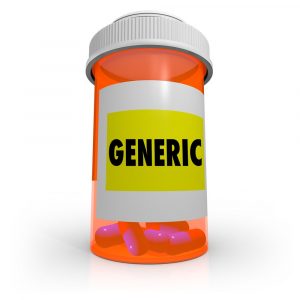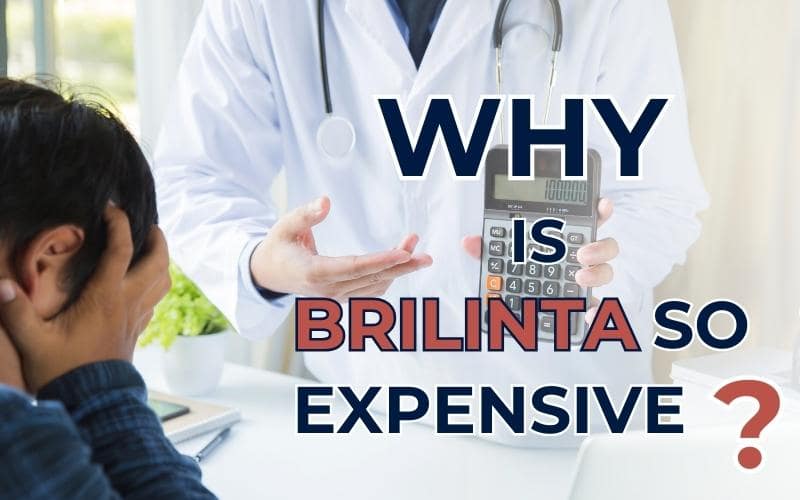Why Is Brilinta So Expensive?
Brilinta is a brand-name, prescription anti-platelet medication. It is an oral tablet given by doctors to certain adults to lower their risk of blood clots and heart problems. US-FDA approved this drug to reduce the risk of death of patients suffering from cardiovascular problems, myocardial infarction, and heart stroke because of acute coronary syndrome or a history of myocardial infarction/heart attack.
Continue reading for details on Brilinta and its cost. This article also has the answer to the most frequently asked question over the internet: Why is Brilinta so expensive?
Brilinta Working Mechanism:

Human blood contains thrombocytes- a type of blood cell, also called blood platelets. The main role of blood platelets is in thrombus (blood clots) formation. The pathophysiology of a thrombus includes cascades of events that ultimately lead to myocardial infarction or stroke.
It includes rupture of atherosclerotic plaque, platelet adhesion, platelet activation, and aggregation of activated platelets at the injury site resulting in the growth of thrombus in various degrees and occlusion.
How does Brilinta work? It works by preventing the activation of platelets and subsequent platelet aggregation and thrombus growth. When platelets are activated, they change their shape and express ADP-releasing receptors. ADP is a potent platelet agonist that can cause thrombus to form.
Brilinta prevents ADP from binding to its binding site on platelets. It reversibly binds to a distinct area on platelets called P2Y12 receptors on the platelets. This results in no signal transduction, needed for activation of platelets and the thrombus formation. Moreover, the reversible binding of the drug allows ticagrelor to get redistributed over the surfaces of new platelets as they are formed.
Price of Brilinta:

What is the price of Brilinta? The price that one has to pay upon purchase of Brilinta medication can vary. Many factors decide the Brilinta cost. These include the treatment plan, the pharmacy chosen, and the insurance coverage. Despite this, why is Brilinta so expensive? Why so? This article will talk about this in detail.
Insurance and Brilinta Cost:
How much does Brilinta cost with and without insurance? In general, Brilinta costs more if the buyer has no insurance plan covering the cost of the drug. Some health insurance plans can help people save money on prescription medications like Brilinta.
The Brilinta cost depends upon one’s purchased insurance plans and one’s prescription copy. The buyers can contact their pharmacy provider or insurance providers to figure out how much their copay will be.
They may have to get prior authorization before their insurance providers cover their cost of Brilinta. If they do not have any help from insurance companies, the buyers can focus on cost-saving information provided by their doctors or pharmacists.
Long-term users of Brilinta can switch to the next section “Help paying for Brilinta” to reduce their expenses on purchase of Brilinta. However, if the concern is about the reason behind the high cost of Brilinta, or why is Brilinta so expensive, read on for more details.
Help Paying for Brilinta:
To get help to pay for the high Brilinta price, one can check out some online resources, Brilinta saving cards, and the Medicine Assistance tool. These resources share valuable information about insurance and drug assistance programs as well as provide links to saving cards and other services.
Long-term Brilinta users can reduce the overall cost of their drug therapy by choosing a 90-day supply of Brilinta. Another convenient option is to use a reputable online pharmacy like OffshoreCheapMeds to have Brilinta delivered directly to your doorstep, eliminating the need for in-person visits to traditional pharmacies. Moreover, users may also benefit from rebates when filling their Brilinta prescriptions.
Take advantage of the best prices for both brand and generic versions of Brilinta by placing an order with OffshoreCheapMeds today.
Generic Brilinta:

Is there a generic for Brilinta? Yes, generic Brilinta is available. It contains Ticagrelor as its active ingredient. Its generic form Ticagrelor by manufacturer Hisun Pharm Hangzhou was FDA-approved in 2019.
There is a cost difference between a brand-name drug and its generic counterpart. Typically, brand-name drugs like Brilinta are priced higher than their generic alternatives. At OffshoreCheapMeds, we offer both the brand-name and generic versions of Ticagrelor. Take advantage of our competitive pricing for both options.
Curious to know why is Brilinta so expensive. Move on to the main next section of the article, why is Brilinta so expensive, and learn more in detail. Choose now OffshoreCheapMeds to buy Brilinta online at the best cost.
Why Is Brilinta So Expensive?

Brilinta price is so expensive in some places. There are many factors at play in raising the overall cost of Brilinta. To know why is Brilinta so expensive, one must be aware of these cost-deciding factors:
The Research and Development (R&D) Excuse:
Brilinta is a brand-name prescription drug. As it is a trade name, it needs to undergo years of clinical drug research and testing to ensure its safety and efficacy for its users. The expenses in research and testing of the brand name drug cause its price to shoot up, making it one of the most prominent reasons why is Brilinta so expensive.
Complicated Patent Laws:
Pharmaceutical companies are allowed to have a patent for a brand-name drug lasting for only 20 years. This allowance was given by the US government to pharmaceutical companies to let them make up for their R&D investments. This means the maker of a brand-name drug like Brilinta can only sell the drug for 2 decades.
Thereafter, other drug-makers can make generic versions of the brand-name drug which can increase competition in the market between Brilinta and other drugs having the same active ingredient as Brilinta. The competition in the drug market and less need for clinical studies for generic drugs, results in its lower cost as compared to Brilinta.
The Law of Economics: Direct Relationship between Price and Demand
This means, that as there is more demand for brand-name, antiplatelet drugs like Brilinta, their price is high. The demand is more because patients who are at risk of heart attack and strokes would prefer to pop a pill rather than go for other treatments when they have to lower their risk of death. These are some of the reasons why is Brilinta so expensive.
Marketing Costs:
Pharmaceutical firms spend heavily on marketing brand-name drugs, passing the expenditures to customers, and increasing prices.
R&D for Alternatives:
Developing alternative medications or combination therapies can increase research and development costs, affecting medicine pricing.
Production Standards:
Rigid regulatory standards for manufacturing and quality control add to the production costs of brand-name drugs.
Regulatory Processes:
Navigating complex drug approval and post-market surveillance processes requires significant investments, contributing to overall costs.
Supply Chain Costs:
Storage, transportation, and distribution expenses play a role in the total price of Brilinta.
Conclusion:
In conclusion, the high cost of Brilinta, like many other prescription drugs, results from a complex interplay of factors including research, marketing, regulations, and industry pricing strategies. This issue poses challenges for patients and healthcare professionals.
Understanding Brilinta’s cost sheds light on broader pharmaceutical industry challenges. For more details on why is Brilinta so expensive and potential solutions, please refer to the full article, “Why Is Brilinta so Expensive?” We hope our article offers valuable insights into this crucial matter.
FAQs:
Is Brilinta a blood thinner?
Yes. Brilinta is not a blood thinner as anticoagulants like warfarin and heparin but it is an antiplatelet medication that can impact blood clotting and increase the risk of bleeding. Brilinta is classified as a P2Y12 inhibitor (Platelet aggregation inhibitor).
It works by making blood platelets less sticky. With the use of Brilinta, platelet aggregation gets inhibited and thus there is a reduced risk of blood clot formation in arteries. Therefore, Brilinta users have lower chances of having a heart stroke or heart attack.
How long does Brilinta stay in your system?
The half-life of Brilinta medication is about 7 hours. This means, your body can clear half a dose of Brilinta drug in about 7 hours. Clinical studies have found that daily users of Brilinta show traces of Brilinta drug in their system for about 5 days following their last dose.
Is Brilinta an anticoagulant?
No. Brilinta belongs to the pharmacological class: Platelet aggregation inhibitors- Antiplatelet drugs. Although antiplatelet drugs and anticoagulants are both prescribed to prevent blood clots, their mechanism of working varies.
Antiplatelet drugs like Brilinta are a type of blood thinners that have a role in different sites of the clotting cascade. These work to stop the activation of platelets which further prevents the adhesion of platelets and so does not allow blood clots to form in arteries.
Does Brilinta cause shortness of breath?
Yes. Brilinta has an active ingredient Ticagrelor which is known to cause shortness of breath (Dyspnea) for some of its users. As per some clinical trials, 14 to 21% of Brilinta users have reported experiencing difficulty in breathing or shortness of breath.
This drug-induced side effect is usually mild to moderate but bothersome. It is the result of an increase in adenosine plasma level and inhibition of nucleoside transporter.
Does Brilinta affect the kidneys?
Yes. Brilinta poses a serious risk of causing kidney damage or acute kidney injuries. Those taking Brilinta may experience symptoms of kidney stones such as pain in the back and side or below the ribs and painful urination.
In addition, taking Brilinta with statins is known to cause drug-drug interactions and lead to significant kidney damage. Therefore, doctors usually advise to undergo regular kidney function tests while on therapy with Brilinta.

